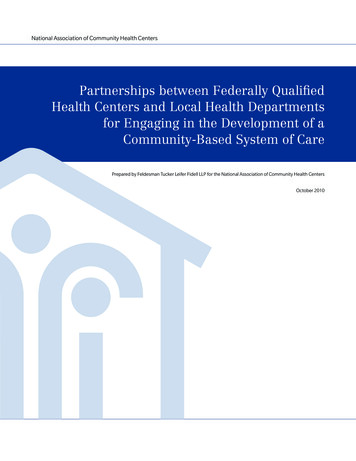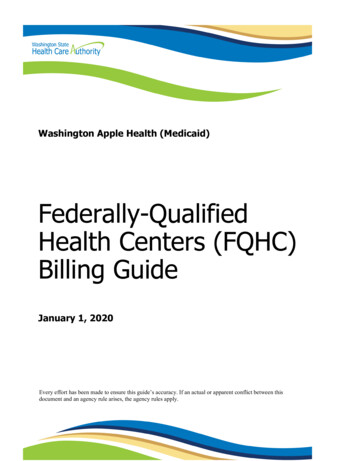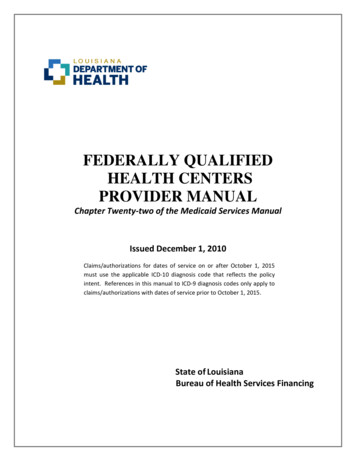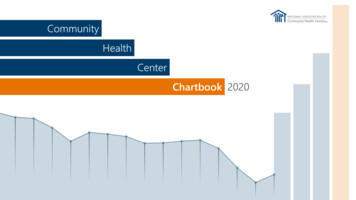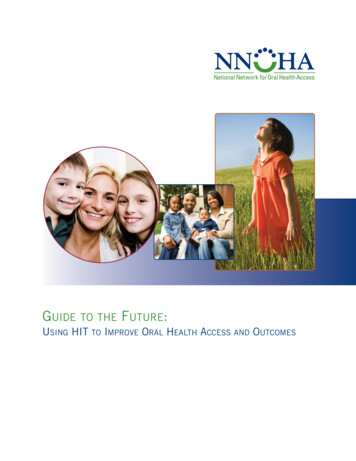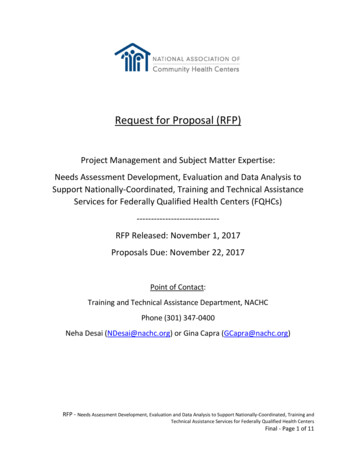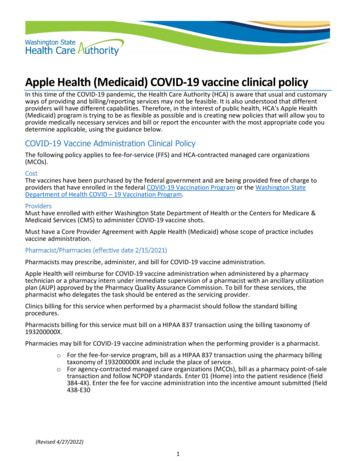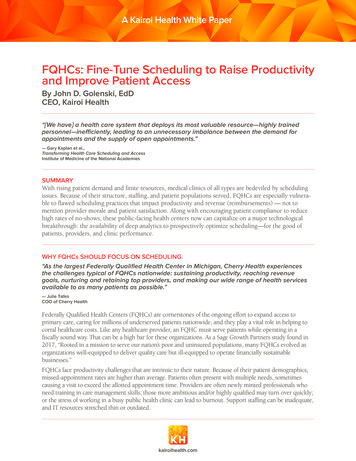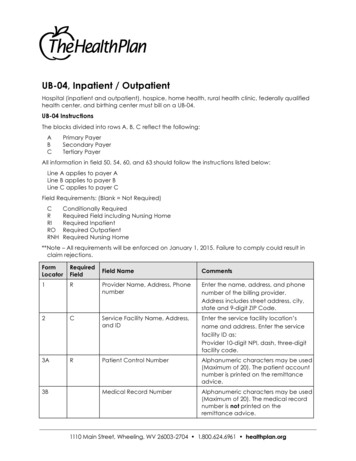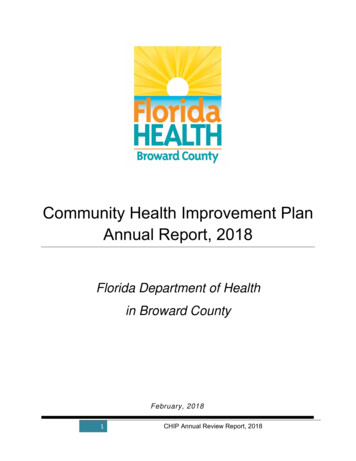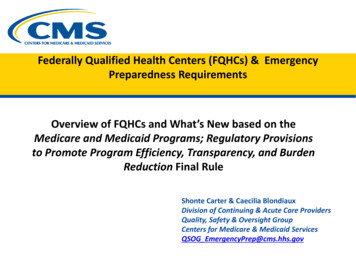
Transcription
Federally Qualified Health Centers (FQHCs) & EmergencyPreparedness RequirementsOverview of FQHCs and What’s New based on theMedicare and Medicaid Programs; Regulatory Provisionsto Promote Program Efficiency, Transparency, and BurdenReduction Final RuleShonte Carter & Caecilia BlondiauxDivision of Continuing & Acute Care ProvidersQuality, Safety & Oversight GroupCenters for Medicare & Medicaid ServicesQSOG EmergencyPrep@cms.hhs.gov
Overview & Agenda Overview of the Federally Qualified Healthcare Centers(FQHCs) Provide an overview of the recent regulatory changes as theyrelate to the Emergency Preparedness Medicare Condition. Review each of the core elements of the EmergencyPreparedness Program Additional clarifications made over the last few months
FQHC Overview FQHCs must remain in substantial compliance with all of theFQHC regulatory requirements specified in 42 CFR Part 405,Subpart X, and in 42 CFR Part 491, with the exception ofSection 491.3. Unlike RHCs, FQHCs do not undergo initial/recertificationsurveys. Instead, they are subject to a filing procedure. Underthis procedure, the FQHC self-attest that it is in substantialcompliance and will remain in substantial compliance with allapplicable Medicare regulations. Facilities are expected to be in compliance with the revised EPrequirements effective 11/29/2019.
FQHC Conditions for CoverageTitle 42 - CFR Part 491§491.1 - Purpose and scope§491.2 - Definitions§491.3 - Certification procedures (not applicable for FQHCs)§491.4 - Compliance with Federal, State and local laws§491.5 - Location of clinic§491.6 - Physical plant and environment§491.7 - Organizational structure§491.8 - Staffing and staff responsibilities§491.9 - Provision of services.§491.10 - Patient health records.§491.11 - Program evaluation.§491.12 - Emergency preparedness
State Agency Survey If CMS receives a credible allegation(s) of noncompliance with theMedicare requirements and health and safety standards found at 42CFR 405 and 42 CFR 491, the State Survey Agency (SA) will conduct aunannounced complaint survey investigation on behalf of CMS. To determine whether the FQHC is in substantial compliance with theMedicare requirements, SAs (or CMS regional offices, in the case oftribal FQHCs) follow the general complaint survey process located inChapter 5 of our State Operations Manual (SOM), particularly §§5200 –5240 and Appendix G. (See Chapter ance/Manuals/Downloads/som107c05pdf.pdf andAppendix G: ce/Manuals/downloads/som107ap g rhc.pdf
Complaint Investigation – Compendious Review In general, a complaint investigation is a focused surveyconducted on the specific regulatory requirement(s) related tothe allegation, but the SA can expand the scope of review asnecessary to determine compliance or noncompliance. If deficiencies are cited, the SA documents the deficiencies onthe Form CMS-2567 and obtains an acceptable Plan ofCorrection (PoC). The Form CMS-2567 is the official document that communicatesthe determination of compliance or noncompliance with Federalrequirements. Also, it is the form that the FQHC would use tosubmit a plan to achieve compliance, i.e., the PoC.
COVID-19 Flexibilities CMS is committed to taking critical steps to ensureAmerica’s healthcare facilities can respond to the threatof COVID-19. All healthcare facilities are encouraged to monitor theCDC website for information and resources and contacttheir local health department when needed (CDCResources for Health Care Facilities).
RHC and FQHC Flexibilities in Response toCoronavirus Disease 2019 (COVID-19)To assist RHCs and FQHCs in furnishing services duringthe COVID-19 PHE, CMS has temporarily waivedregulatory requirements applicable to the following: 50% mid-level staffing requirement for RHCs; Physician supervision requirement for nursepractitioners (NPs), (to the extent permitted by State law),and Location requirements for existing RHCs and FQHC toallow additions of temporary service locations.
Details for Flexibilities The flexibilities are retroactively effective beginningMarch 1, 2020 Expires at the end of the emergency declaration andCMS issues an end of outbreak notification. Only apply to existing RHCs and FQHCs
Physician Supervision of NPs During the PHE, NPs may function to the fullest extentpossible without physician supervision, and to theextent of applicable state law. Physician continues to be responsible for providing theoverall medical direction for the RHC/FQHC’s healthcare activities, consultation for, and medical supervisionof all other health care staff, either in person orthrough telehealth and other remote communications.
Temporary Locations During the COVID-19 PHE, CMS is allowing currentlyapproved RHCs/FQHCs to provide patient care servicesin temporary expansion to help address the urgentneed for supplementary care. The temporary site may include a parking lot. Temporary sites are not restricted to the rural/shortagearea location requirements. Each location is obligated to meet the same RHC/FQHCregulations as the main site, to the extent not waived.
Temporary Locations (cont’d) The RHC/FQHC is expected to be operating in a manner notinconsistent with its state’s emergency preparedness plan. FQHCs must also have an updated Health Resource andService Administration (HRSA) Notice of Award, expandingthe scope of service to include the temporary location(s) tosupport response to the COVID-19 PHE. Providing all requirements are met, services provided at atemporary site may be provided under the permanentlocation’s CMS Certification Number (CCN)
Temporary Locations (cont’d)Patient’s Vehicle During the COVID-19 PHE, to help minimizetransmission, an RHC/FQHC visit can take place if:‒ the patient is in a vehicle on the premises of the RHC/FQHCand all requirements for a billable visit are met (e.g.medically-necessary, face-to-face visits with an RHC/FQHCpractitioner).‒ All services provided are held to all RHC/FQHC regulations,unless otherwise waived. This includes, but is not limited to,the provisions of services as per 42 CFR 491.9(c).
Temporary Locations (cont’d)Patient’s Vehicle‒ RHCs/FQHCs must consider the clinical appropriateness ofservices before conducting a visit and/or treating a patient intheir vehicle. The RHC/FQHC would provide the services using itsexisting CCN.
Temporary Location (cont’d)State’s Emergency Preparedness Plan. An RHC/FQHC seeking approval of its temporary location is notinconsistent with its state’s emergency preparedness plan. Retain any communications with the State emergencypreparedness representatives to demonstrate that its temporarylocation(s) are not inconsistent with the state emergencypreparedness and pandemic plan for the COVID-19 PHE. Once the state has approved the addition of temporarylocation(s), there are no additional CMS enrollment or reportingrequirements. The RHC/FQHC may begin utilizing the temporaryexpansion location throughout the duration of the COVID-19PHE.
Temporary Location (Cont’d)COVID-19 PHE Ends All waived CoPs, CfCs, requirements, and mosttemporarily revised regulations will terminate at theend of the PHE. If the RHC/FQHC wishes to continue services at thetemporary expansion location after the PHE has ended,the facility must submit form 855A to begin the processof enrollment and initial certification as a RHC/FQHCunder the regular process and meet all applicablerequirements, including 42 CFR 491.5.
FQHC Resources Appendix G – Guidance for Surveyors: Rural Health Clinics Appendix Z – Guidance: Emergency Preparedness for All Providerand Certified Supplier TypesQSOG EmergencyPrep@cms.hhs.govQSOG RHC-FQHC@cms.hhs.gov
Additional FQHC Resources Medicare FFS Billing FAQ document available d-19-faqs508.pdf. CMS MLN Article - FQHCs furnishing telehealth services during thePHE, https://www.cms.gov/files/document/se20016.pdf COVID-19 FAQs Non-Long Term Care te-care-facilities-individuals-intellectual.pdf Additional waiver mary-covid-19-emergencydeclaration-waivers.pdf
FQHC Emergency PreparednessEmergency Preparedness Rules
Final Rules Original Emergency Preparedness Final Rule: Medicare andMedicaid Programs; Emergency Preparedness Requirementsfor Medicare and Medicaid Participating Providers andSuppliers (2016) Revisions to Emergency Preparedness Requirements: Medicareand Medicaid Programs; Regulatory Provisions to PromoteProgram Efficiency, Transparency, and Burden Reduction(2019)20
Important Reminders The Final Rule for Emergency Preparedness published in 2016and provisions were updated with the Burden Reduction FinalRule published 2019. Emergency Preparedness still applies to all 17 provider andsupplier types Compliance required for participation in Medicare Emergency Preparedness is ONE CoP/CfC of many alreadyrequired
Primary Changes as of 2019’s Burden Rule Review & Updates:‒ Plans, policies and procedures, communication plan reducedto at least every 2 years (annually for LTC). Review/updatesshould still occur as needed with changes. Training/Testing‒ For outpatient providers, revised the requirement such thatonly one testing exercise is required annually, which may beeither one community-based full-scale exercise, if available,or an individual facility-based functional exercise, every otheryear and in the opposite years, these providers may choosethe testing exercise of their choice.
What’s New- Appendix Z Updates On March 26, 2021, CMS has made several updates to Appendix Z of theState Operations Manual (SOM). Revisions include:– Recommendations during PHE’s for facilities to monitor Centers forDisease Control and Prevention (CDC) and other public health agencies,which may issue event-specific guidance and recommendations tohealthcare workers.– Added additional guidance on risk assessment considerations, to includeEIDs– Added additional guidance/considerations for emerging infectiousdiseases (EID) planning to include personal protective equipment (PPE).– Expanded guidance on the identification and use of best practicesrelated to reporting of facility needs, the facility’s ability to provideassistance and occupancy reporting.– Expanded guidance for surge planning due to natural disasters and EIDs.– Included planning considerations for potential patient surges andstaffing needs.– Added additional planning considerations for hospices during EIDsoutbreaks.
What’s New- Appendix Z Updates (Cont.)– Expanded guidance and added clarifications related to alternate caresites and 1135 Waivers.– Added new definitions based on the Omnibus Burden ReductionFinal Rule expansion of acceptable testing exercises.– Revised guidance related to training and testing program as theBurden Reduction Rule extensively changed these requirements,especially for outpatient providers.– Provided clarifications related to testing exercise exemptions when aprovider/supplier experiences an actual emergency event.– Clarified expectations surrounding documentation of the emergencyprogram.– Expanded surveyor guidance to ensure Life Safety Code and healthsurveyors communicate/collaborate surrounding potentialdeficiencies for alternate source energy.– Clarified existing guidance
Four Provisions for All Provider TypesRisk Assessment and PlanningPolicies and n PlanTraining and Testing8
Risk Assessment and Planning Develop an emergency plan based on a risk assessment. Perform risk assessment using an “all-hazards” approach,focusing on capacities and capabilities. Facilities must still have a process for cooperation andcollaboration with local, tribal (as applicable), regional, State,and Federal emergency preparedness officials' efforts tomaintain an integrated response during a disaster or emergencysituation. Update emergency plan at least every 2 years (annually for LTC)9
All-Hazards Approach: An all-hazards approach is an integrated approach to emergencypreparedness that focuses on identifying hazards and developingemergency preparedness capacities and capabilities that canaddress those as well as a wide spectrum of emergencies ordisasters. This approach includes preparedness for natural, man-made, andor facility emergencies that may include but is not limited to:care-related emergencies; equipment and power failures;interruptions in communications, including cyber-attacks; loss ofa portion or all of a facility; and, interruptions in the normalsupply of essentials, such as water and food; and emerginginfectious disease (EID) threats.7
Additional Guidance for EID Planning CMS does not specifically define infectious disease or whichtypes to include in the risk assessment/plan. Some examples of EID’s may include, but are not limited to:‒ Potentially infectious Bio-Hazardous Waste‒ Bioterrorism‒ Pandemic Flu‒ Highly Communicable Diseases (such as Ebola, Zika Virus,SARS, or novel COVID-19 or SARS-CoV-2)
Additional Guidance for EID Planning EID’s should be identified within a facility’s risk assessment. EID’s may be localized to a certain community or be widespread(as seen with the COVID-19 PHE) and therefore plans forcoordination with local, state, and federal officials are essential. Consider having infection prevention personnel involved in theplanning, development and revisions to the EP program, as theseindividuals would likely be coordinating activities within thefacility during a potential surge of patients.
Policies and Procedures Develop and implement policies and procedures based on theemergency plan and risk assessment, and the communicationplan. Policies and procedures must address a range of issues includingsubsistence needs, evacuation plans, procedures for sheltering inplace, tracking patients and staff during an emergency. Review and update policies and procedures at least every 2years (annually for LTC).10
P&P Additional Clarifications/Guidance Appendix Z provides additional guidance related to incorporatingEID’s into the facility’s policies and procedures. This includedoverarching themes of:‒ Surge Planning Considerations‒ Reporting of Facility Needs and Ability to Provide Assistance‒ Contingency of Services and Operations For example, facilities must have policies which address theirability to respond to a surge in patients requiring care. Asrequired, these policies and procedures must be aligned with afacility’s risk assessment, and should include planning for EIDs.10
Reminders and Important Notes When developing transfer agreements, facilities must take intoaccount the patient population and the ability for the receivingfacility to provide continuity of services. If a facility has a transfer arrangement with another facility andthis facility could not accommodate all patients, then the facilityshould plan accordingly to provide continuity of services withanother facility who could receive the remaining residents.
Reminders and Important NotesContinued Facilities should also take into account the availability ofcontracted resources during an emergency event. For instance, afacility has a written arrangement with a transportationcompany, yet during an emergency the transportation companyis unable to reach the facility due to flooding and/or havingother arrangements with the community. The facility is responsible to ensure these areas are discussedand managed within their policy and procedure to ensureavailability of resources during an emergency event. It would be appropriate for the facility to have discussions withtransportation vendors about their competing contracts duringan emergency and the vendor’s continuity of business plans inthe event of an emergency.
Communication Plan Develop a communication plan that complies with both Federaland State laws. Coordinate patient care within the facility, across health careproviders, and with state and local public health departmentsand emergency management systems. Review and update plan at least every 2 years (annually for LTC). Updated Appendix Z also provides additional considerations forfacility’s on reporting occupancy and sharing information withemergency management systems.11
Training and Testing Program Develop and maintain a training and testing program includinginitial training in policies and procedures, based on theemergency plan, risk assessment, policies & procedures and thecommunication plan. Review and update the training and testing program at leastevery 2 years.12
Training Requirements Conduct initial training in emergency preparedness policies andprocedures to all new and existing staff, individuals providingservices under arrangement, and volunteers After initial training, provide emergency preparedness trainingevery 2 years (Annually for LTC) Demonstrate staff knowledge of emergency procedures. Maintain documentation of all emergency preparedness training. If the emergency preparedness policies and procedures aresignificantly updated, conduct training on the updated policiesand procedures.36
Additional Guidance for Training Program Training refers to a facility’s responsibility to provide educationand instruction to staff, contractors, and facility volunteers toensure all individuals are aware of the emergency preparednessprogram. For training requirements, the facility must have a processoutlined within its emergency preparedness program whichencompasses staff and volunteer training complementing therisk assessment. The training for staff should at a minimum include trainingrelated to the facility’s policies and procedures.
New Definitions for Testing Functional Exercise (FE): “FEs are designed to validate andevaluate capabilities, multiple functions and/or sub-functions, orinterdependent groups of functions. FEs are typically focused onexercising plans, policies, procedures, and staff membersinvolved in management, direction, command, and controlfunctions” as defined by HSEEP. We have attempted to align ourdefinitions with those guidelines. For additional details, please visit HSEEP guidelines located 269861/HSEEP RevisionApr13 Final.pdf/65bc7843-1d10-47b7-bc0d-45118a4d21da
New Definitions for Testing Mock Disaster Drill: A drill is a coordinated, supervised activityusually employed to validate a specific function or capability in asingle agency or organization. Drills are commonly used toprovide training on new equipment, validate procedures, orpractice and maintain current skills. For example, drills may be appropriate for establishing acommunity-designated disaster receiving center or shelter. Drillscan also be used to determine if plans can be executed asdesigned, to assess whether more training is required, or toreinforce best practices.
New Definitions for Testing Workshop: A workshop, for the purposes of thisguidance, is a planning meeting/workshop whichestablishes the strategy and structure for an exerciseprogram, as defined by HSEEP. We have attempted toalign our definitions with those guidelines. For additional details, please visit HSEEP guidelines.
Testing Changes with Burden Reduction For outpatient providers: Facilities are required to only conductone testing exercise on an annual basis, which may be either onecommunity-based full-scale exercise, if available, or an individualfacility-based functional exercise, every other year and in theopposite years, these providers may choose the testing exerciseof their choice. These outpatient providers are required to conduct one full-scaleor individual facility based exercise every two years, and in theopposite years, the providers can conduct testing exercise ofchoice, which can include either a full-scale, individual facilitybased, drill, tabletop exercise/workshop which includes afacilitator.41
Testing Exercises- Reminder CMS is not specifying a minimum number of staff which mustattend these exercises, however facility leadership anddepartment heads should participate in each exercise. A sufficient number of staff should participate in the exercise totest the scenario and thoroughly assess the risk, policy,procedure, or plan being tested If an exercise is conducted at the individual facility-based leveland is testing a particular clinical area, the expectation is thatstaff who work in this clinical area participate in the exercise fora clear understanding of their roles and responsibilities.
Testing Exercises- Reminder Additionally, facilities can review which members of staffparticipated in the previous exercise, and include those who didnot participate in the subsequent exercises to ensure all staffmembers have an opportunity to participate and gain insight andknowledge. CMS added additional clarification to Appendix Z related totesting exercises and defined “community partners” in relationto facility exercises. Community partners are considered any emergencymanagement officials (fire, police, emergency medical services,etc.) for full-scale and community-based exercises, however canalso mean community partners that assist in an emergency, suchas surrounding providers and suppliers.
Testing Exercise- Exemption If a facility experiences an actual natural or man-madeemergency that requires activation of the emergency plan, thefacility is exempt from engaging in its next required communitybased or individual, facility-based functional exercise followingthe onset of the actual event. Exemption only applies to the NEXT REQUIRED full-scaleexercise. Facilities must demonstrate activation of the emergency plan.
Outpatient Provider Scenarios Scenario #1. Facility X conducted a full-scale exercise inJanuary 2019 and a table-top exercise as their exerciseof choice for January 2020 (opposite year). In March2020, Facility X activates its emergency preparednessprogram due to the COVID-19 Public Health Emergency(PHE).Question #1: When must the facility conduct its nextrequired full-scale exercise? What is the exemptionbased on the requirements?
Outpatient Provider ScenariosAnswer #1: The facility is exempt from the January 2021full-scale exercise for that “annual year” and is requiredto complete an exercise of choice by January 2022.
Outpatient Provider Scenarios Scenario #2. Facility Y conducted a table top exercise inJanuary 2019 as the exercise of choice and conducted afull-scale exercise in January 2020. In March 2020,Facility Y activates its emergency preparednessprogram due to the COVID-19 PHE.Question #2: When must the facility conduct its nextrequired full-scale exercise? What is the exemptionbased on the requirements?
Outpatient Provider ScenariosAnswer #2: The facility is exempt from the January 2022 fullscale exercise for that “annual year”. However, the facility mustconduct its exercise of choice by January 2021, and again inJanuary 2023
Outpatient Provider Scenarios Scenario #3. Facility Z conducted a table top exercise inJune 2019 (based on its annual cycle). It is scheduled toconduct a full-scale exercise in June 2020. In March2020, Facility Z activates its emergency preparednessprogram due to the COVID-19 PHE.Question #3: When must the facility conduct its nextrequired full-scale exercise? What is the exemptionbased on the requirements?
Outpatient Provider ScenariosAnswer #3: The facility is exempt from the June 2020 scheduledfull-scale exercise for that “annual year” and is required tocomplete an exercise of choice in June 2021, and a following fullscale exercise in June 2022. It is exempt from its next required fullscale or individual facility-based exercise which would have beenin June 2020.
Documentation Requirements Facilities must be able to demonstrate, through writtendocumentation, that they activated their program dueto the emergency. During natural disasters, facilities generally showactivation by providing notice of imminent weather tostaff; showing documentation of evacuations; closuresetc. There is no need to submit any documentation.
Reminders and Important Notes While we encourage the use of healthcare coalitions, werecognize this is not always feasible for all providers andsuppliers. For facilities participating in coalitions, we are not specifying the“level” of participation. However, if facilities use healthcarecoalitions to conduct exercises or assist in their efforts forcompliance, we ask this would be documented and in writing.
State & Accrediting Organization Requirements The Emergency Preparedness Rule does not specify quantitieswithin any provisions. The rule is broad and overarching. Facilities should check with their State Survey Agencies andAccrediting Organizations (as applicable) for any additionalrequirements which may exceed the CMS requirements. During public health emergencies such as pandemics, theCenters for Disease Control and Prevention (CDC) and otherpublic health agencies may issue event-specific guidance andrecommendations. Facilities are recommended to have aprocess to ensure monitoring of event-specific guidance.
Where are we now? Changes are effective upon implementation of the BurdenReduction Final Rule - November 29, 2019, no grace period. Our Surveyor Training (available publically) is under developmentto reflect the Burden Reduction Final Rule changes as well asCMS’s additional guidance added to Appendix Z. We would recommend facilities use the checklists developed byASPR to help guide them to their specific requirements. Reviewthe checklists under Facility-Specific Requirement Overviews athttps://asprtracie.hhs.gov/cmsrule. Consider annotating on the checklist, the location of each ofyour elements of the plan to assist surveyors reviewing on-site
The QSOG EP Website Providers and Suppliers should refer to the resources on the CMSwebsite for assistance in developing emergency preparednessplans. The website also provides important links to additional resourcesand organizations who can assist. We will be working onrevisions to FAQs and other resources for the next severalmonths to reflect the new changes ndCertification/SurveyCertEmergPrep/index.html19
Thank you!
Medicare and Medicaid Programs; Regulatory Provisions to Promote Program Efficiency, Transparency, and Burden Reduction Final Rule Shonte Carter & Caecilia Blondiaux. Division of Continuing & Acute Care Providers. Quality, Safety & Oversight Group. Centers for Medicare & Medicaid Services. QSOG_EmergencyPrep@cms.hhs.gov
